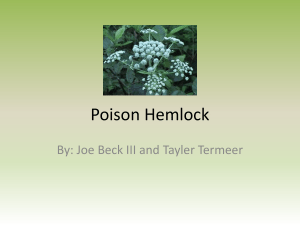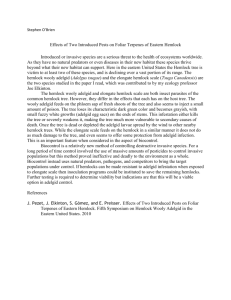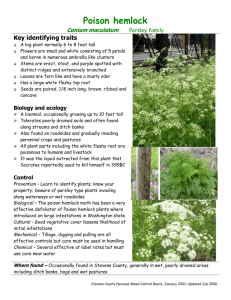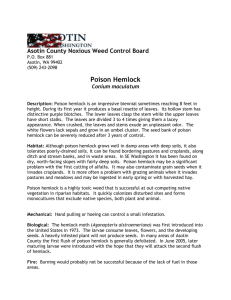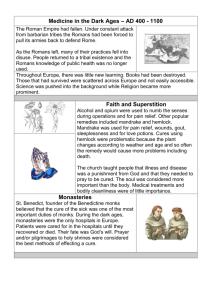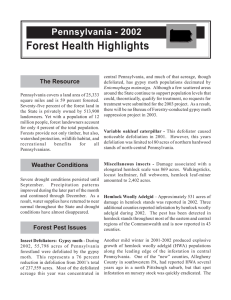Rapid Early Detection of Hemlock Wooly Roger Mech Robert Heyd
advertisement
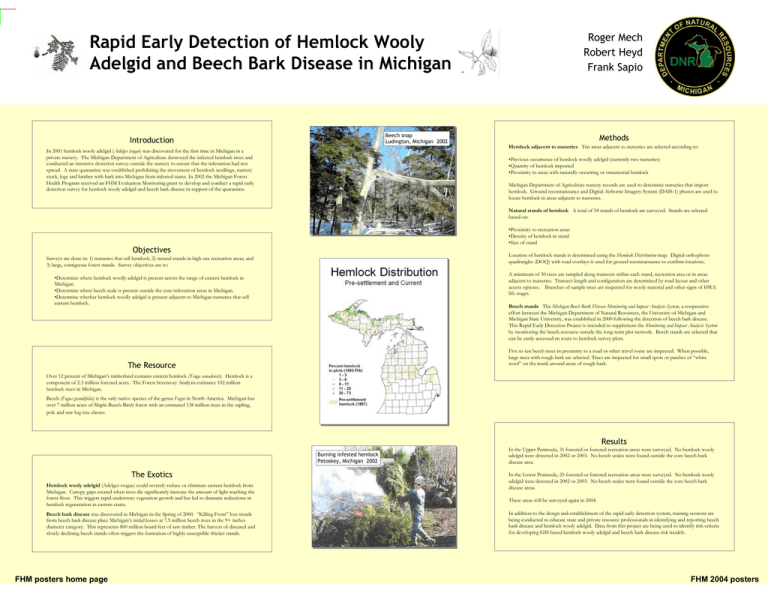
Roger Mech Robert Heyd Frank Sapio Rapid Early Detection of Hemlock Wooly Adelgid and Beech Bark Disease in Michigan Beech snap Ludington, Michigan 2002 Introduction In 2001 hemlock wooly adelgid (Adelges tsugae) was discovered for the first time in Michigan in a private nursery. The Michigan Department of Agriculture destroyed the infected hemlock trees and conducted an intensive detection survey outside the nursery to ensure that the infestation had not spread. A state quarantine was established prohibiting the movement of hemlock seedlings, nursery stock, logs and lumber with bark into Michigan from infested states. In 2002 the Michigan Forest Health Program received an FHM Evaluation Monitoring grant to develop and conduct a rapid early detection survey for hemlock wooly adelgid and beech bark disease in support of the quarantine. Methods Hemlock adjacent to nurseries Ten areas adjacent to nurseries are selected according to: •Previous occurrence of hemlock woolly adelgid (currently two nurseries) •Quantity of hemlock imported •Proximity to areas with naturally-occurring or ornamental hemlock Michigan Department of Agriculture nursery records are used to determine nurseries that import hemlock. Ground reconnaissance and Digital Airborne Imagery System (DAIS-1) photos are used to locate hemlock in areas adjacent to nurseries. Natural stands of hemlock A total of 54 stands of hemlock are surveyed. Stands are selected based on: •Proximity to recreation areas •Density of hemlock in stand •Size of stand Objectives Location of hemlock stands is determined using the Hemlock Distribution map. Digital orthophoto quadrangles (DOQ) with road overlays is used for ground reconnaissance to confirm locations. Surveys are done in: 1) nurseries that sell hemlock; 2) natural stands in high-use recreation areas; and 3) large, contiguous forest stands. Survey objectives are to: A minimum of 30 trees are sampled along transects within each stand, recreation area or in areas adjacent to nurseries. Transect length and configuration are determined by road layout and other access options. Branches of sample trees are inspected for wooly material and other signs of HWA life stages. •Determine where hemlock woolly adelgid is present across the range of eastern hemlock in Michigan. •Determine where beech scale is present outside the core infestation areas in Michigan. •Determine whether hemlock woolly adelgid is present adjacent to Michigan nurseries that sell eastern hemlock. Beech stands The Michigan Beech Bark Disease Monitoring and Impact Analysis System, a cooperative effort between the Michigan Department of Natural Resources, the University of Michigan and Michigan State University, was established in 2000 following the detection of beech bark disease. This Rapid Early Detection Project is intended to supplement the Monitoring and Impact Analysis System by monitoring the beech resource outside the long-term plot network. Beech stands are selected that can be easily accessed en route to hemlock survey plots. Five to ten beech trees in proximity to a road or other travel route are inspected. When possible, large trees with rough bark are selected. Trees are inspected for small spots or patches of “white wool” on the trunk around areas of rough bark. The Resource Over 12 percent of Michigan’s timberland contains eastern hemlock (Tsuga canadensis). Hemlock is a component of 2.3 million forested acres. The Forest Inventory Analysis estimates 102 million hemlock trees in Michigan. Beech (Fagus grandifolia) is the only native species of the genus Fagus in North America. Michigan has over 7 million acres of Maple-Beech-Birch forest with an estimated 138 million trees in the sapling, pole and saw log size classes. Results Burning infested hemlock Petoskey, Michigan 2002 The Exotics Hemlock wooly adelgid (Adelges tsugae) could severely reduce or eliminate eastern hemlock from Michigan. Canopy gaps created when trees die significantly increase the amount of light reaching the forest floor. This triggers rapid understory vegetation growth and has led to dramatic reductions in hemlock regeneration in eastern states. Beech bark disease was discovered in Michigan in the Spring of 2000. “Killing Front” loss trends from beech bark disease place Michigan’s initial losses at 7.5 million beech trees in the 9+ inches diameter category. This represents 800 million board feet of saw timber. The harvest of diseased and slowly declining beech stands often triggers the formation of highly susceptible thicket stands. FHM posters home page In the Upper Peninsula, 31 forested or forested recreation areas were surveyed. No hemlock wooly adelgid were detected in 2002 or 2003. No beech scales were found outside the core beech bark disease area. In the Lower Peninsula, 25 forested or forested recreation areas were surveyed. No hemlock wooly adelgid were detected in 2002 or 2003. No beech scales were found outside the core beech bark disease areas. These areas will be surveyed again in 2004. In addition to the design and establishment of the rapid early detection system, training sessions are being conducted to educate state and private resource professionals in identifying and reporting beech bark disease and hemlock wooly adelgid. Data from this project are being used to identify risk criteria for developing GIS-based hemlock wooly adelgid and beech bark disease risk models. FHM 2004 posters
